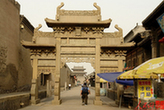a.Brief Introduction
This Mountain is located in the northern part of Jiangxi Province, to the south of the Yangtze River and northwest of Poyang Lake. The picturesque Mountain is well known in China. The scenic area, covering 302 square km, houses 16 natural wonders, 474 scenic spots and 171 peaks.
The scenery in the Lushan scenic area is breathtaking. It is full of sheer peaks and precipices, changeable clouds and fogs, silver springs and flying waterfalls. The flora is diverse and comprises about 3,000 species. Features of glaciation during the Quaternary Period make Mt. Lushan even more mysterious. There are millions of migratory birds in the Poyang Lake area. The dancing of the largest number of cranes over the water makes it a world wonder.
Lushan abounds in historic and cultural relics. The great historian of the Han Dynasty, Sima Guang, climbed Mt. Lushan, and wrote about it in his classic The Historical Records. Bailudongshuyuan (White Deer Cave Academy) was the most famous of the four biggest academies in ancient China, and enjoys high prestige in the Chinese history of education.
Donglin Temple (East Grove Temple), built by eminent monks in the Eastern Jin Dynasty, was the birthplace of the Jintu (Pure Earth) sect of Buddhism. More than 1,500 noted figures in history visited this Mountain, leaving behind some 4,000 pieces of verse and over 900 inscriptions on the cliffs, as well as other writings, prints and calligraphic works. There are about 600 villas here, with the styles of 18 nations and cultures.
b.Cultural Heritage
According to legend, Yu the Great, who conquered devastating floods in primeval times, visited Lushan. Emperor Qin Shihuang also visited the Mountain when he toured the south. Poets and scholars of every dynasty were attracted to Lushan and inspired to compose numerous works. Among them were Tao Qian of the Jin Dynasty, Li Bai and Bai Juyi of the Tang Dynasty, Su Shi, Zhou Dunyi, Zhu Xi and Li Shizhen of the Song Dynasty, and Xu Xiake of the Ming Dynasty.





Why not rent a boyfriend, or girlfriend to please parents during the Spring Festival?